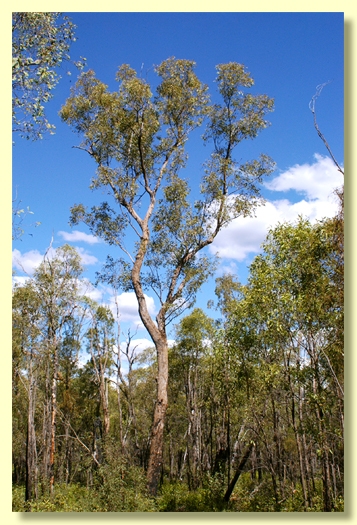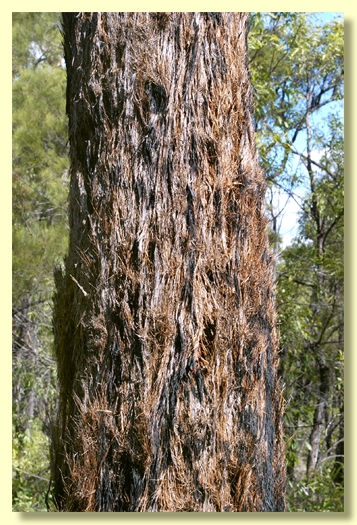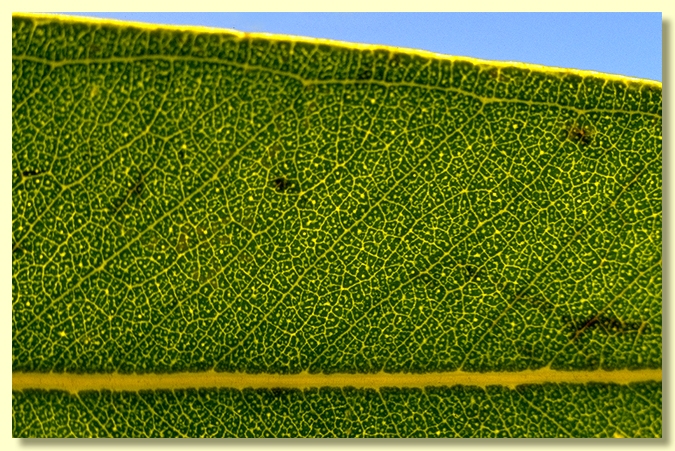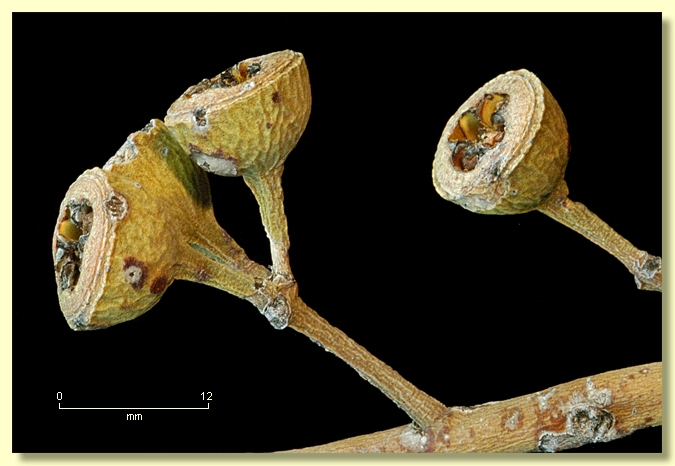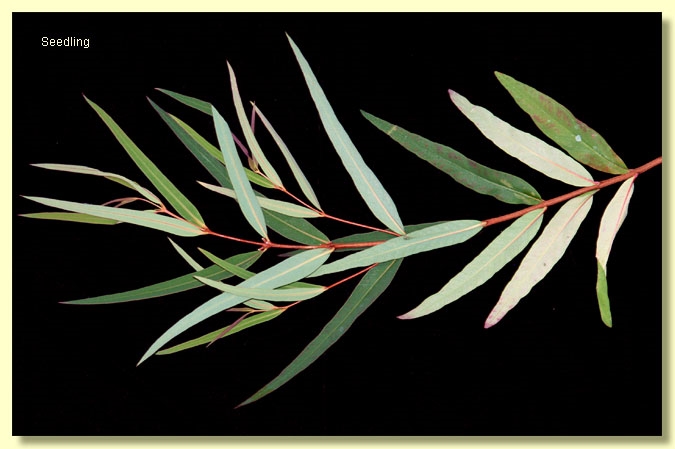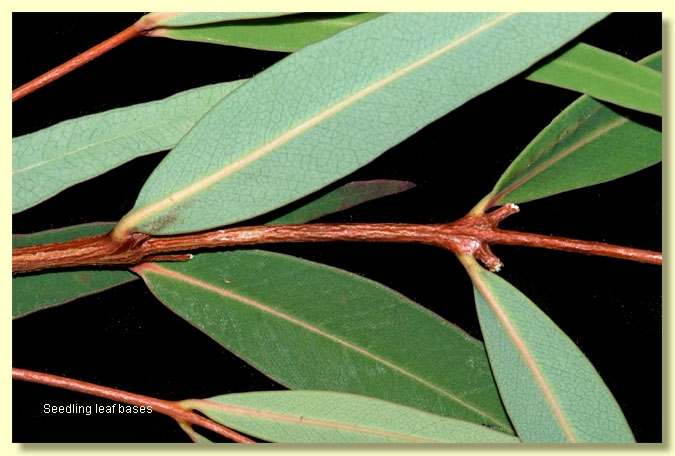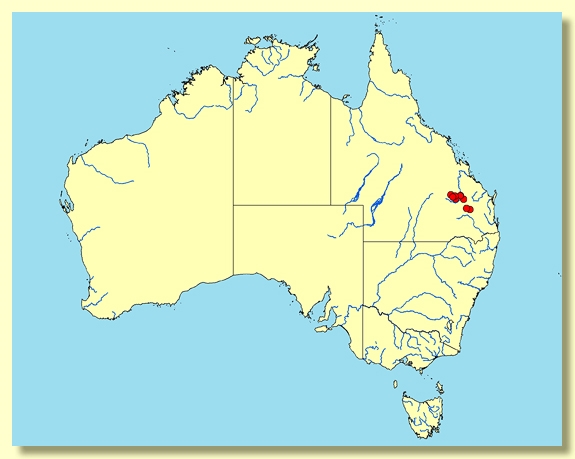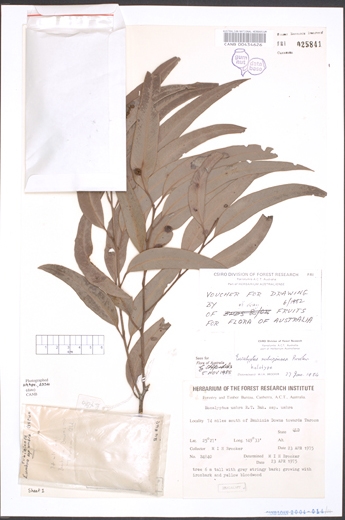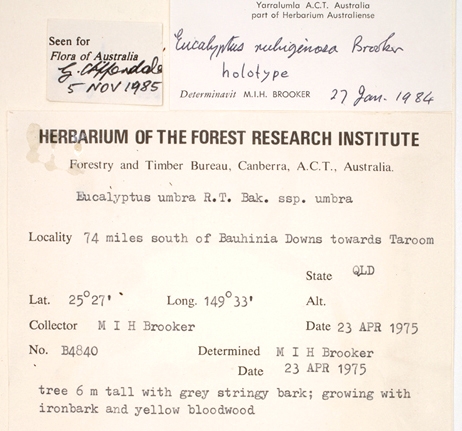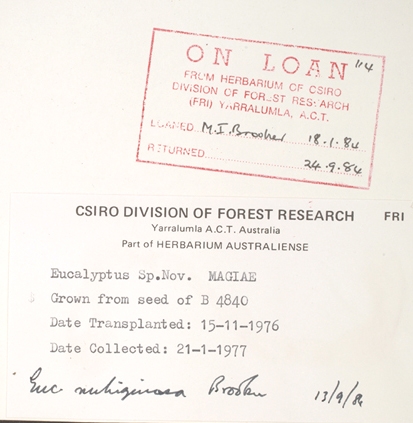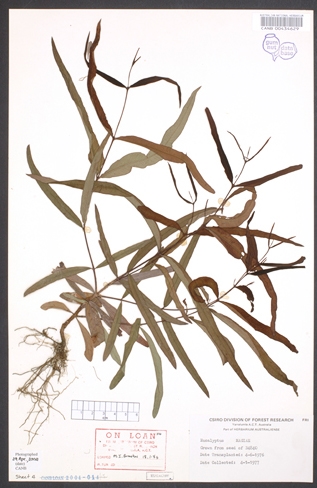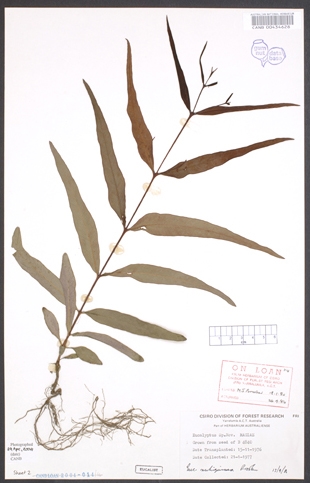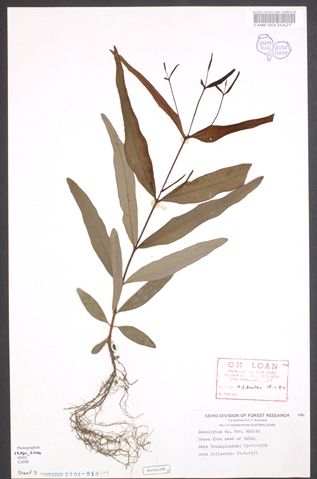Eucalyptus | Primitiva
Euclid - Online edition
Eucalyptus rubiginosa
Eucalyptus rubiginosa Brooker, Austral. For. Res. 14: 311 (1984).
T: 119 km S of Bauhinia Downs towards Taroom, Queensland, 23 April 1975, M.I.H.Brooker 4840 & D.A.Kleinig; holo: CANB; iso: AD, BRI, MEL, NSW.
Tree to 15 m tall. Lignotuber present.
Bark rough to 2 cm diameter branches, softly fibrous, thick, reddish-brown.
Branchlets lack pith glands, glabrous.
Juvenile growth (coppice or field seedlings to 50 cm): stems ? square in cross-section, smooth; juvenile leaves shortly petiolate, opposite for up to 10 pairs then alternate, narrowly lanceolate, 10–15 cm long,1.5–3 cm wide, bases tapering, discolorous, dull, green.
Adult leaves alternate, petiole 0.8–2(2.4) cm long; lanceolate or falcate, 7–15 cm long, 1–3 cm wide, base tapering to petiole, margin entire, apex pointed, dull, discolorous, dark green above, side-veins at an acute or wider angle to midrib,densely reticulate, intramarginal vein parallel to and just within margin, oil glands island and intersectional.
Inflorescence terminal compound but with a terminal vegetative shoot that grows out afterwards, peduncle narrowly angular, 0.5–2.6 cm long, buds in umbels of 9 or 11, pedicels 0.5–1 cm long. Mature buds ovoid, 0.8–1.1 cm long, 0.4–0.7 cm wide, scar absent, operculum conical, stamens inflexed, anthers cuboid to ± ovoid, versatile, dorsifixed, dehiscing by longitudinal slits (non-confluent), style long, stigma blunt, locules 4 or 5(6), the placentae each with 4 vertical ovule rows. Flowers white.
Fruit pedicellate (pedicels 0.5–1 cm long), cupular to hemispherical, 0.6–0.9 cm long, 0.9–1.2(1.5) cm wide, 0.5–0.9 cm long, disc ± level, rarely slightly raised or descending, valves 4 or 5(6), near rim level.
Seeds dark brown, 1.7–2.3 mm long, pyramidal or cuboid, dorsal surface ± smooth, hilum terminal.
Cultivated seedlings (measured at ca node 10): cotyledons reniform; stems ± square in cross-section; leaves always shortly petiolate, opposite for 10+ pairs, lanceolate, 9–15.5 cm long, 0.4–2 cm wide, base tapering, margin entire, apex pointed, discolorous, dull, green.
Flowering has been recorded in September and October (September - November in Brooker & Kleinig, 1994).
A tree endemic to Queensland, found in the sandstone hill country south of Bauhinia Downs and Theodore, especially at Isla Gorge National Park, but also further south in Barakula State Forest north of Chinchilla. Eucalyptus rubiginosa prefers stony rises and rocky ridges where soil is sandy or skeletal. It is characterised by the finely fibrous red-brown rough bark, terminal inflorescence, buds that lack an outer operculum (and hence have no operculum scar), dull green leaves that are darker above than on the underside and more or less hemispherical fruit.
Eucalyptus rubiginosa is most likely to be confused with species of White mahogany, namely E. mediocris and E. acmenoides. White mahogany species have the same general appearance, especially the bark, inflorescence and fruit. E. mediocris differs in usually having a glossy-leaved crown of concolorous leaves and E. acmenoides a crown of glossy leaves much paler on the underside. The most important differences between E. rubiginosa and the White mahoganies are terminal versus axillary inflorescences, and structures inside the buds. Inside the buds the ovules of E. mediocris and E. acmenoides are consistently arranged in two rows in each locule, whereas in E. rubiginosa they are arranged in four rows per locule. This feature will always separate E. rubiginosa from any species of White mahogany or stringybark, but it requires a careful longitudinal dissection of the bud to see ovules — the terminal inflorescence is a more useful field characteristic.
In the classification of Brooker (2000) Eucalyptus rubiginosa is placed by itself in Eucalyptus subgenus Primitiva because of the unusual combination of characters especially terminal inflorescences, buds lacking the outer sepaline operculum, ovules in four vertical rows, anthers with non-confluent dehiscence slits, seeds cuboid to pyramidal with a terminal hilum, leaves discolorous and bark finely fibrous. The white mahogany species are placed in Eucalyptus subgenus Eucalyptus.
Eucalyptus rubiginosa: from Latin rubiginosus, meaning rusty, referring to the red-brown colour of the fibrous bark.

